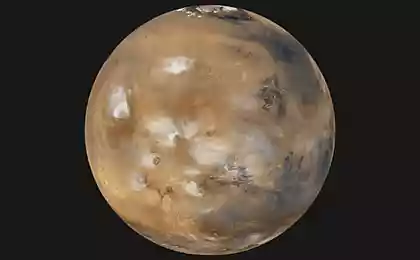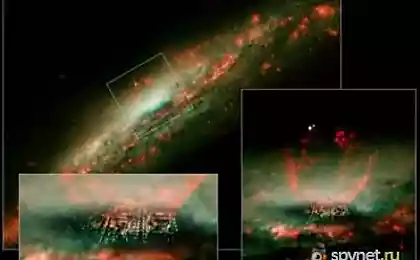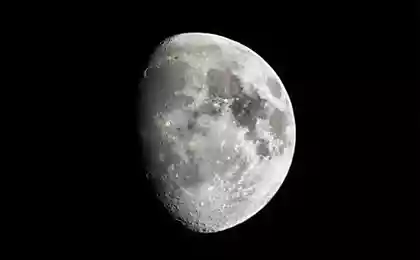194
10 mysteries of the solar system
Mercury in artificial colors ©NASA / JHU Applied Physics Lab / Carnegie Inst. Washington's Venusian vortex
The giant vortex formation near the Venusian south pole looks like a thunderstorm cloud – without rain or lightning. Its diameter is 1800 km, height is 18 km, and there is a vortex at an altitude of 41 km above the surface of the planet.
In 2013, scientists discovered that we are not talking about one, but two vortices with two separate centers of rotation, which are at different heights. They are constantly dissociating and reconnecting, although according to the calculations of scientists should have merged into a single whole long ago.
There is an assumption that this behavior is due to the specifics of the atmosphere of the planet, which rotates 60 times faster than Venus itself. However, the exact relationship between the two phenomena has not yet been established.
©ESA/VIRTIS/INAF-IASF/Obs. de Paris-LESIA/Universidad del País Vasco (I. Garate-Lopez)
Mysterious Iapetus
Automatic interplanetary station "Cassini", which became in 2004 the first artificial satellite of Saturn, discovered on Iapetus majestic ridge height of 18 km (Mount Everest, for comparison, about twice lower).
This ridge extends almost across the entire equator of the Saturnian moon. According to one theory, the mysterious Iapetus had its own ring, which settled in the form of a mountain range.
Other researchers suggest that the ridge was formed as a result of a collision of a satellite with an asteroid, which caused seismic activity.
©NASA/JPL/Space Science Institute
Spider on Mercury
The strange formation was photographed in 2008 by the spacecraft “Messenger”, flying near the smallest planet in the solar system. It is a system of furrows emanating from a common center in the middle of the heat plain. These furrows stretch for many hundreds of kilometers.
The strange formation was named the Pantheon Fossae after the similar dome structure of the Roman Pantheon. Scientists also call it the “Spider.”
The cause of the mysterious structure on Mercury is unknown. Scientists suggest that the furrows may have arisen as a result of specific volcanic activity on the planet.
NASA/Johns Hopkins University Applied Physics Laboratory/Carnegie Institution of Washington
Ugly Miranda.
Even NASA once described the fifth largest moon of Uranus as a “Frankenstein monster.” Miranda seems to be made of different pieces that do not quite fit together. Between these pieces are ridges and troughs, some of which are 12 times deeper than the famous Grand Canyon.
According to one theory, Miranda was once split by a giant asteroid, but its parts did not fly apart, but again attracted to each other, creating such a formless formation.
©NASA/JPL
Mysterious spots on Uranus
In 2006, Hubble and Keck telescopes detected a dark spot on Uranus. Similar spots have previously been found on Neptune. Most likely, we are talking about vortices in the atmosphere of these ice giants, but their exact origin is unknown.
Five years later, astronomers noticed another spot – only a white spot, 10 times brighter than the planet’s visible atmosphere. At the same time, it turned out that it is very close to the dark, making a pair with it. The answer to the causes of the formation of twin spots on the planet may be able to give a space probe aimed at Uranus.
NASA/Space Telescope Science Institute
Ceres geysers
Ceres is the largest asteroid and at the same time the largest dwarf planet of the solar system. Water reserves on it more than in all rivers and lakes on Earth.
With the help of the Herschel space telescope, it was possible to notice giant jets of steam, which the dwarf planet periodically throws into outer space. Geysers have been discovered in the dark regions of the planet.
According to one theory, it is in these places that Ceres is particularly active in absorbing sunlight: the ice quickly turns into steam, which is ejected outward. Other scientists suggest volcanic activity on the largest asteroid.
©NASA, ESA, and A. Feild (STScI)
The Structure of Mercury
The structure of Mercury is one of the greatest mysteries of the cosmos. The diameter of its solid core is more than half of the entire diameter of the planet, proportionally five times more than similar Earth parameters.
It is believed that the upper layers were demolished in the collision with the asteroid, or they were “blown out” The Sun at an early stage of planet formation in the outer solar system.
MESSENGER Teams, JHU APL, NASA
The Ashlight of Venus
The faint glow, which can be seen on the unlit side of Venus during the crescent phase, was first discovered back in 1643. Since then, it has been observed many times, but this phenomenon has not received a satisfactory explanation.
According to one version, ash light causes the atmospheric electricity of the planet: frequent lightning strikes illuminate the Venusian sky. However, the Cassini spacecraft, which flew by the planet, failed to detect the high-frequency interference that should cause such lightning.
©NASA
Io's volcanoes
Jupiter’s monstrous gravitational pull pulls Io in one direction, while the gas giant’s other moons in the opposite direction. As a result of the influence of these tidal forces on Io, a monstrous volcanic activity occurs - more than on any other celestial body in the solar system.
Some volcanoes eject lava jets 375 km above the surface of Jupiter's moon. However, the location of these volcanoes raises serious questions for scientists: it is very different from the theoretically calculated parameters for tidal forces affecting Io.
This means that the theoretical models are wrong. For example, Io can rotate faster than astronomers believe.
Galileo Project, JPL, NASA
Chaos
Chaotic terrain, or simply chaos, is a concept from cosmic geology. It is used to describe strange structures on the surface of planets and moons: a disorderly combination of cracks, plateaus, mountain ranges, etc. Similar structures have been found on Mars and Jupiter’s moon Europa.
The largest chaos of Mars with a diameter of 714 km is called the “Chaos of Aurora”. We are talking about giant plateaus separated by gorges. One version of the origin of this chaos is the release of a large amount of water resources from under the surface of the planet.
This is indicated by the fact that many of the channels of dried up Martian rivers originate in regions of chaos. However, the reason for this release of water remains a mystery.
©NASA
source
Source: /users/147
To visit someone else's body - really + video
Toyota has refused to release a hybrid sports car, the GT86























